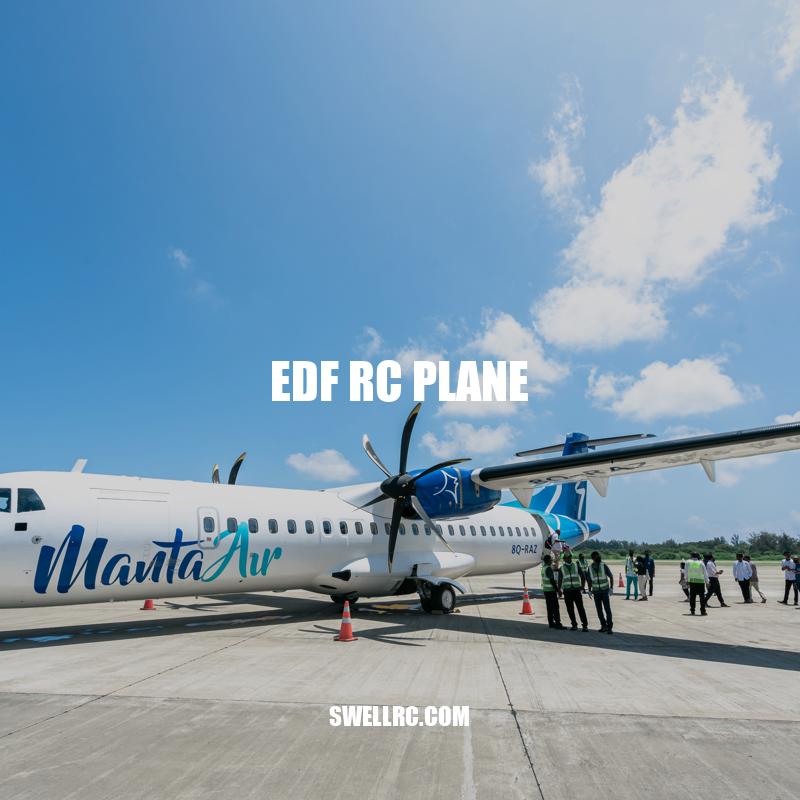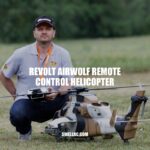Exploring the World of EDF RC Planes: Types, Benefits, and Maintenance
The EDF RC plane is a unique and exciting type of radio-controlled plane that is growing in popularity among hobbyists and enthusiasts. An EDF plane, or electric ducted fan plane, is powered by a series of electric motors driving a ducted fan. Unlike traditional propeller planes, the design of an EDF plane is more streamlined and compact making it more efficient. EDF planes offer many benefits such as longer flight times, quieter operation and increased maneuverability. There are several types of EDF RC planes available in the market, including trainers, jets, and gliders. Each type of EDF RC plane has its unique characteristics and offers a different flying experience. Beginners can opt for user-friendly trainer planes while jet planes are more advanced and offer higher speeds.
When choosing an EDF RC plane, it is important to consider factors like skill level, budget, and intended use. Beginners should opt for trainer planes, while experienced pilots can try advanced models like jets. Budget is also a critical factor, as EDF planes can range from affordable to expensive. Flying an EDF RC plane requires some knowledge and skill. The basics of flying an EDF RC plane include takeoff, flight and landing. Beginners should start with a trainer plane and practice in a spacious, open area.
Proper maintenance of your EDF RC plane is crucial to keep it in good condition. Tips for maintaining your plane include checking the motor, propeller, and battery regularly. Batteries are the most delicate part of EDF planes and should be handled with care. Common problems that arise include propeller damage, battery failure, and motor issues. By considering factors like your skill level, budget, and intended use, you can choose the perfect EDF RC plane for you. EDF planes require proper maintenance and understanding, but the rewards are worth it.
Types of EDF RC Planes
There are several types of EDF RC planes available in the market each with its unique characteristics that offer a different flying experience. They are classified into three, namely:
1. Trainers
- Great option for beginners and intermediate pilots.
- Usually made of foam and are durable and light.
- Feature a wide wing and large control surfaces to make flying easier.
- Great for practicing basic flying skills such as handling basic controls, flying in a straight line and making turns.
- Examples of Trainer EDF RC planes include the Starmax A-10 Thunderbolt II Twin 64mm EDF Jet, the E-flite Viper 70mm EDF and the Dynam Hawker Tempest 1250mm Wingspan EPO Warbird RC Airplane.
2. Jets
- More advanced and offer higher speeds and performance.
- Often made with lightweight but strong materials like carbon fiber or fiberglass.
- Require higher skill levels and experience to fly.
- Provide an adrenaline rush to pilots with their speed and aerobatic capabilities.
- Examples of Jet EDF RC planes include the F-16 Fighting Falcon, the F-35 Lightning II, and the T-45 Goshawk.
3. Gliders
- Powered by the force of nature and require no fuel or batteries.
- Capable of soaring for long periods of time and can perform smooth and graceful maneuvers.
- Great option for lazy flying and relaxing in the air.
- Examples of glider EDF RC planes include the E-Flite UMX Whipit DLG and the Glider Brushed Motor Sky Surfer RC Airplane.
Now that you have an idea of the different types of EDF RC planes, it’s time to choose the right one for you based on your skill level, budget, and intended use. Some great websites to look for EDF RC planes include Horzion Hobby, Nitroplanes, and Motion RC. These websites provide a wide range of planes to choose from different types, makes, models, sizes, and prices.
What is EDF in RC planes?
EDF in RC planes stands for Electric Ducted Fan. These fans operate with less noise and more efficiency, while still offering the RC hobbyists the potential to experience the thrill of seeing their winged replicas soar through the air. EDF planes run with multi-bladed propellers, taking in air and spinning at high speeds. For more information on RC planes and accessories, you can visit websites like HobbyKing, RC Universe, or Horizon Hobby.
Choosing the right EDF RC plane requires careful consideration of different factors, such as your skill level, budget, and intended use. Here are some tips that can help you choose the perfect EDF RC plane for you:
- Take an honest assessment of your flying skills and experience.
- Choose a plane that matches your skill level. Beginners should start with trainer models, while advanced pilots can opt for jets.
- Consider your budget. EDF RC planes range from affordable to expensive. Set a budget and stick to it.
- Think about where you’ll fly your plane. Indoor and outdoor spaces have different size requirements.
- Consider the type of flying you want to do. Do you want to practice basic flying skills, aerobatic maneuvers or just fly for fun and relaxation?
- Read reviews and watch videos of the EDF RC plane to get an idea of its capabilities and limitations.
- Check out different websites and stores that offer EDF RC planes to compare the prices and features of different models. Websites like Horizon Hobby, Nitroplanes, and Motion RC offer a wide range of EDF RC planes to choose from.
- Consult with experienced pilots or hobby shops for guidance and advice on choosing the right EDF RC plane for your needs.
It’s also important to note that owning an EDF RC plane requires maintenance to keep it in good condition. Checking the motor, propeller, and battery regularly is a must. Batteries are the most delicate part of EDF planes, and proper handling is essential.
Here is a table that compares some EDF RC planes based on their features, prices, and ratings.
| Model | Type | Wingspan (in) | Price | Rating |
|---|---|---|---|---|
| Starmax A-10 Thunderbolt II Twin 64mm EDF Jet | Trainer | 20.9 | $289.00 | 4.0/5 |
| E-flite Viper 70mm EDF BNF Basic Electric Ducted Fan Jet Airplane | Jet | 42.9 | $359.99 | 5.0/5 |
| Dynam RC P-61 Black Widow 1.5M Twin-Engine Electric Brushless RC Airplane ARF | Trainer | 53.9 | $419.99 | 4.5/5 |
| FMS Futura V2 80mm EDF Jet | Jet | 41.5 | $535.99 | 5.0/5 |
Reading reviews and watching videos of the EDF RC planes can give you a better idea of which one to choose. These websites provide a great shopping experience, and you can find various models with different capabilities and prices.
What is the best beginner EDF RC plane?
For beginner EDF RC planes, the MiG-15 and the twin EDF-powered A-10 Warthog are good options to consider. It’s important to use high-quality, high discharge-rating LiPo batteries for optimal performance. If flying larger EDF jets (70 mm, 80 mm, or 90 mm), it’s recommended to buy six-cell 3,200 mAh or larger battery packs. No specific websites or products were mentioned.
Flying an EDF RC Plane
EDF RC plane flying can be a fun and rewarding experience. However, it does require some knowledge and skill. Here are some tips for flying an EDF RC plane:
– Start with a trainer plane, especially if you’re a beginner.
– Choose a spacious area that is free from obstructions, people, and pets to fly your plane.
– Perform a pre-flight check of your plane by inspecting the motor, battery, and propeller. Make sure everything is in good working order.
– Takeoff: Wind up the plane’s motor to full throttle, and gently toss the plane into the air. Once the plane reaches a safe altitude, give it some throttle, and control the direction with the rudder.
– Flight: Practice basic maneuvers like turns, stalls, and glides. Gradually increase the complexity of maneuvers as your skills improve.
– Landing: Approach the landing strip slowly and carefully. Reduce the power of the plane and glide down before gently putting the plane down.
– Fly in good weather conditions with little to no wind. Avoid flying in extreme weather like rain, snow, high winds, and thunderstorms.
– Follow safety guidelines and laws when flying your plane. In most cases, it is permitted to fly the EDF RC plane on open unpopulated areas. However, it is necessary to check the laws in your area before flying your plane.
Before and after each flight, it is essential to maintain and inspect your EDF RC plane for any damage or wear and tear. Proper storage is also critical to ensure the longevity of your EDF RC plane. Some websites like HobbyKing, which is a popular retail shop for RC enthusiasts, offer a range of accessories like battery chargers, motors, and propellers to keep your EDF RC plane in top condition. These websites also have instructional videos, forums, and other resources that can help you get the most out of your flying experience.
What does EDF mean for RC planes?
EDF stands for Electric powered ducted fan. It is a type of propulsion system that has become increasingly popular for RC planes, specifically model jets. The ducted fan is a mechanical fan or propeller that generates thrust and is mounted within a cylindrical duct or shroud. EDF jets offer a great alternative to traditional gas turbine-powered model jets. If you want to learn more, you can check out the Wikipedia page on ducted fans at https://en.wikipedia.org/wiki/Ducted_fan.
Maintenance of EDF RC Plane
Maintaining your EDF RC plane is crucial to ensure its longevity and continued efficient performance. Here are some tips for maintaining your EDF RC plane:
- Regularly check the motor, battery, and propeller for damage or wear and tear.
- Use a soft and clean cloth to clean the plane and remove dirt and debris that may affect its performance.
- Store your EDF RC plane in a dry and secure place, and ensure all parts are detached and protected from harm.
- Charge the battery of the EDF RC plane with its specific charger and battery settings. Overcharging or undercharging might damage the battery.
- Always use and install quality parts and accessories to maintain the EDF RC plane’s proper functioning. Cheap parts might damage your aircraft.
If you encounter any issues with your EDF RC plane, there are resources available to help you. Some websites such as Motion RC, EDF Jets, and Grayson Hobby offer a variety of spare parts and accessories for EDF RC planes, as well as support and information about troubleshooting problems. These sites also provide instructional videos, forums, and other resources that can help you get the most out of your flying experience.
Can a beginner fly an EDF jet?
Flying EDF Jets is not recommended for beginners due to their power and speed. EDF Jets use a ducted fan with no propeller, which generates a lot of thrust and requires a certain level of skill to control. It is recommended that beginners start with smaller and slower planes to gain experience before moving onto EDF Jets. There are many websites and products available for beginners to get started in the hobby of RC flying, such as RCGroups.com and Horizon Hobby’s Apprentice S 15e RTF Beginner Airplane.
Flying an EDF RC Plane
Flying an EDF RC plane requires practice, patience, and a good knowledge of its fundamental aspects. Here are some tips to help you fly your EDF RC plane like a pro:
- Get a beginner EDF RC plane to start, it will help you learn and gain experience.
- Choose a flying location that is spacious, open, and away from crowds or obstructions.
- Ensure all controls of the EDF RC plane are configured properly before the flight.
- Start with a low power setting and gradually increase the speed as you gain confidence.
- Practice different moves, such as turns, loops, and stalls, to improve your flying expertise.
- Always follow safety guidelines while flying your EDF RC plane, and be aware of any potential hazards or obstacles in the area.
If you are a beginner, there are resources available to help you learn how to fly an EDF RC plane properly. Some websites, such as RC Groups, Flite Test, and RC Universe, provide information about EDF RC planes, as well as user forums, instructional videos, and other resources. You can also find tutorials and online guides that walk you through each step of the learning process. With practice and patience, you can quickly become a skilled EDF RC plane pilot and enjoy the thrilling experience of flying an EDF RC plane.
How do you fly an RC plane for the first time?
Flying an RC plane for the first time can be exciting but also a bit nerve-wracking. Before taking off, it’s important to make sure you understand the controls and have enough open space to fly in. Start by taking small, gradual turns and get a feel for how the plane reacts to your movements. It’s also important to keep an eye on the battery life and not fly too far away from your controller. For more tips and information, check out websites like RCGroups.com and RCPlanet.com. Additionally, purchasing a beginner-friendly RC plane like the HobbyZone Sport Cub S2 or the Ares XView 2 can make your first flight experience easier and more enjoyable.
Conclusion
In conclusion, an EDF RC plane is an excellent choice for enthusiasts who want a thrilling and unique flying experience. With their compact design, electric ducted fan, and long flight times, these planes provide a range of benefits that traditional radio-controlled planes can’t match. From selecting the right plane to practicing the necessary flying techniques, there are many steps to becoming a successful EDF RC plane pilot. But with enough time, commitment, and knowledge, you can gain the expertise you need to fly an EDF RC plane like a pro.
Overall, EDF RC planes are an exciting and fun way to enjoy and explore the world of radio-controlled airplanes. They offer a more efficient and streamlined experience, and they are suitable for a wide range of pilots. Whether you’re a beginner or an experienced RC enthusiast, there’s an EDF RC plane out there that is right for you. So, get started today, and experience the thrill of flying with an EDF RC plane!



